Dr. Phil Zeltzman’s Blog
How do you know if your vet is any good?
This is probably the riskiest post I’ve written in a while.
I’m sorry, there are no cute kittens today. We bravely tackle a critical topic that should matter to every serious pet lover.
OK, but let’s first look at cute kittens anyway…

My hope today is to help you understand an important but mysterious concept: standard of care.
Standard of care is a legal expression, not a medical one.
There are different ways to define standard of care, and they’re rather nebulous and subjective.
. It is the degree of care, or the level of treatment, a reasonably competent and skilled vet should provide, taking into account the current medical knowledge.
. It is the customary practices an “average,” prudent vet would typically offer in similar circumstances.
. It’s the right thing to do to take care of a patient a client trusted us to treat – in an ethical manner.
Problem is, nobody knows what standards of care are. There is no book, no article, no definition of what vets should do in a particular situation.
Standards of care are constantly evolving as medicine improves, new discoveries are made and new drugs are invented. They depend on the treating veterinarian, the practice, the town, the region, the State and the country.
There are guidelines, suggested by various veterinary organizations, but they’re only guidelines.
There are basically 3 levels of standards of care.
1. The gold standard
This is the care typically provided at a vet school, a specialty hospital or a very progressive family practice.
It’s the best and safest way to perform a procedure or arrive at a diagnosis.
The purpose is to reduce risks and complications as much as possible. The end goal is to increase the chances of success as much as possible.
2. Reasonable standard of care
This is what the “average and prudent” vet would agree is reasonable to do for a particular treatment or procedure.
As you can imagine, this is extremely subjective. What might seem reasonable to one vet may seem unreasonable to another. There is no black and white, it’s all shades of gray…
3. Sub-standard care
This level of care is not reasonable or acceptable. It could be called negligence or malpractice.
It could harm the patient – and often does.
And no matter how cheap it is, it is cheating the client.
Sadly, this is what is sometimes portrayed on popular shows on TV… and many pet owners don’t even know it.
OK, if you’re still reading, you deserve to look at more cute kittens.

To better explain those levels, let’s take 5 everyday examples you may be familiar with:
. When we diagnose cancer in a pet, we typically take chest X-rays to check for spreading (metastasis) of the cancer to the lungs. Unfortunately, we can miss tiny masses in the lungs what X-rays simply cannot show. A CAT scan may cost much more, but it’s far better to see those tiny masses. Meanwhile, at some practices, the mass would be removed without even taking chest X-rays.
Which approach would you want for your pet?
. You can sometimes see a mass in the spleen on a simple X-ray. An ultrasound should not only confirm that the mass is truly in the spleen, but it can confirm that all of the other organs in the belly are OK, and that there is no spreading (metastasis) to the liver.
Next up: who does the ultrasound? A family vet who does ultrasound every once in a while, or a specialist who does it 20 times per day?
Which test – and which ultrasonographer – would you want for your pet?
. Some practices will remove a tooth without X-rays and without anesthesia monitoring.
Meanwhile, other practices in the very same town will remove a tooth with a dedicated veterinary nurse monitoring the patient under anesthesia. In addition, they will take X-rays of the jaw before and after removing a tooth.
What level of care would you want for your pet?
. Having a tooth removed is not exactly fun. Some practices don’t prescribe pain medications at all – before, during or after the procedure.
Some practices will dispense a mild pain killer beforehand (e.g. butorphanol) and a mild pain medication to go home (tramadol).
Yet other practices will provide a strong morphine-like drug and an anti-inflammatory before the surgery, will numb the area (local anesthesia, just like at your dentist) before the extraction, and will send home two pain killers (e.g. gabapentin and an anti-inflammatory).
Which one would you want if your pet needed a tooth removed?
. Some practices would not run any bloodwork before doing a procedure under anesthesia.
Some would do basic bloodwork (e.g. a mini-chemistry, which looks at liver and kidney function).
Yet other practices will do full bloodwork (i.e. a full chemistry, a CBC – which looks at red and white blood cells), as well as a urinalysis to check kidney function.
Which one would you want for your pet before anesthesia?
Veterinary medicine is like any other decision in life:
. You can have lunch at McDonald’s or Olive Garden or a fancy steakhouse. You’ll be fed either way.
. You can fix your own sink, or have a plumber fix it, or have a master plumber replace and upgrade it. You’ll have a sink either way.
. You can go to work on a bicycle, in a Ford Fiesta or in a BWM. You’ll get to work either way.
But there is a huge difference here: we’re not talking about lunch, a sink or a car. We’re talking about a living creature, who might go under anesthesia or get major surgery.
The reason vets recommend certain tests is not to drain your bank account.
The reason is to reduce the risk of complications – including death – as much as possible.
The reason is also to improve comfort, decrease pain and increase quality of life.
Are you still with me? Then you totally deserve to look at more cute kittens.

So, what’s a concerned pet lover to do?
. Make sure you compare apples to apples. If you get a $200 estimate from one clinic and a $1,000 for the one across town, don’t assume that one vet is a nice guy and the other is a crook.
. Ask for an explanation of every line item on the estimate. You have a right to understand what you are getting into.
. Ask questions about the procedure itself. Who is doing it? How many times have they done it? What is their success rate with this procedure? Dare to ask these tough questions!
. Ask questions about complications. What are the most common (theoretical) complications you should be prepared for? What (actual) complications has this particular vet observed? What will they do to reduce the risk of complications?
. Ask questions about the things that are usually skipped on “cheaper” estimates: what pain management protocol will they use to make sure your pet is comfortable? Will your pet be monitored during anesthesia? By whom? With what qualifications (or what letters after their name)? Will they do it start to finish, or whenever somebody remembers to do it, or never?
. If you would like to provide the gold standard to your pet but you’re concerned about being able to afford it, then please get pet insurance – a great plan preferably – it will solve 99% of the problem.
Bottom line: make sure you understand the full story behind an estimate, and what it means for the safety of your pet and the success of the procedure.
Phil Zeltzman, DVM, DACVS, CVJ, Fear Free Certified

Dr. Phil Zeltzman is a traveling veterinary surgeon in Pennsylvania & New Jersey. An award-winning author, he loves to share his adventures in practice along with information about vet medicine and surgery that can really help your pets. Dr. Zeltzman specializes in orthopedic, neurologic, cancer, and soft tissue surgeries for dogs, cats, and small exotics. By working with local family vets, he offers the best surgical care, safest anesthesia, and utmost pain management to all his patients. Sign up to get an email when he updates his blog, and follow him on Facebook, too!
Why did Reagan have a toe removed?
Reagan, a 6 year old Doberman, was seen for swelling in one of her left front toes. It wasn’t painful, but it was clearly larger than normal.

A full physical, blood work and radiographs were performed. The physical exam was unremarkable – except for the swollen toe.
Blood work was normal, so she was a good candidate for anesthesia. X-rays showed a concerning area in one of the bones of the toe (what would be your pinky). The bone was clearly abnormal. Look at the red arrows and notice how rough the edges of the bone are compared to the bones in other toes. This can indicate a variety of concerning diseases, from a fungus to cancer.
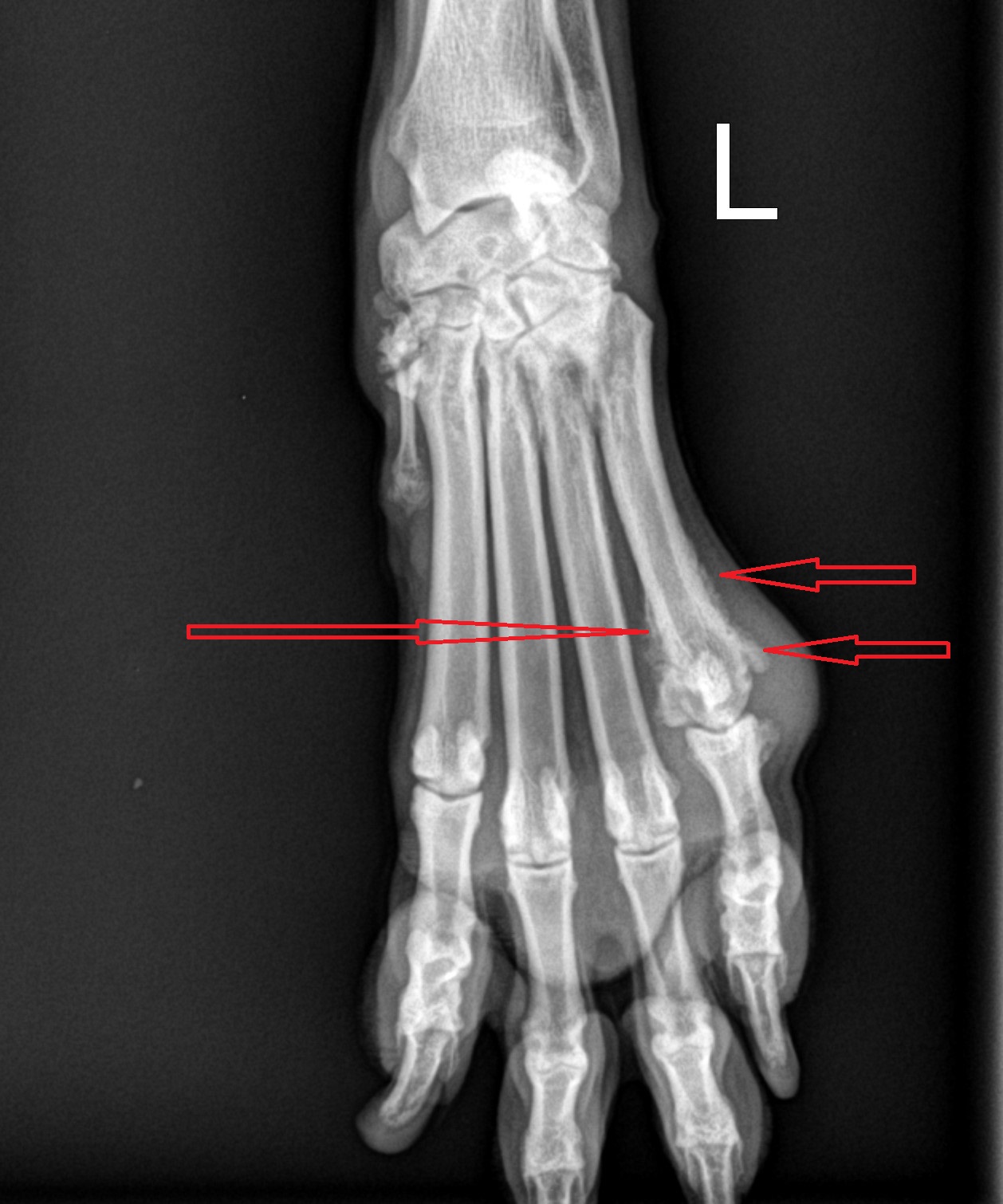
Based on the concern that this was most likely bone cancer, we recommended removing the toe. Sadly, there was no other treatment option. Please be warned, the pictures below are GRAPHIC.
The surgery was straight forward. The entire toe was removed and sent out to the lab to identify the abnormality.
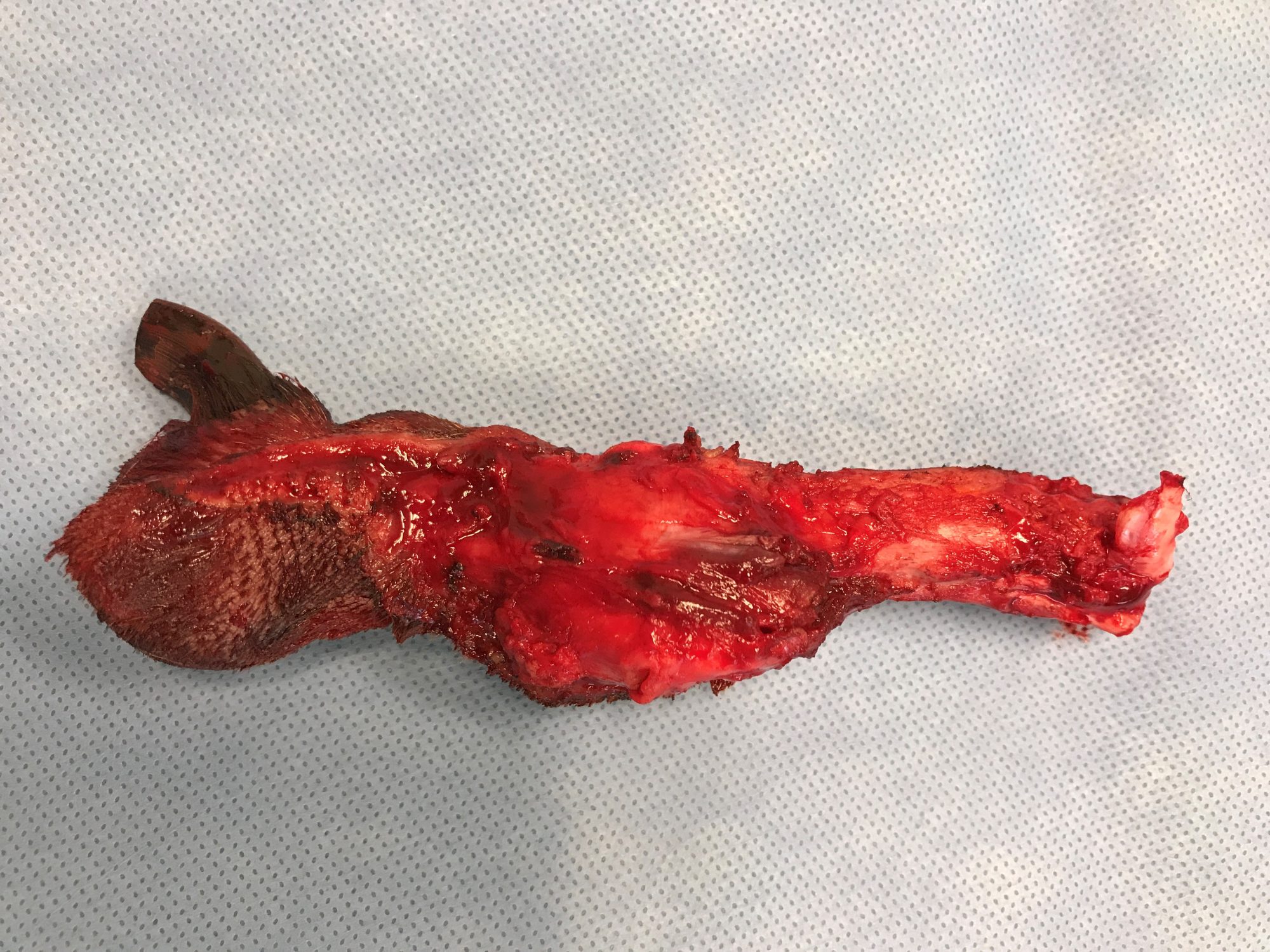
Postop, the foot looks pretty cosmetic.
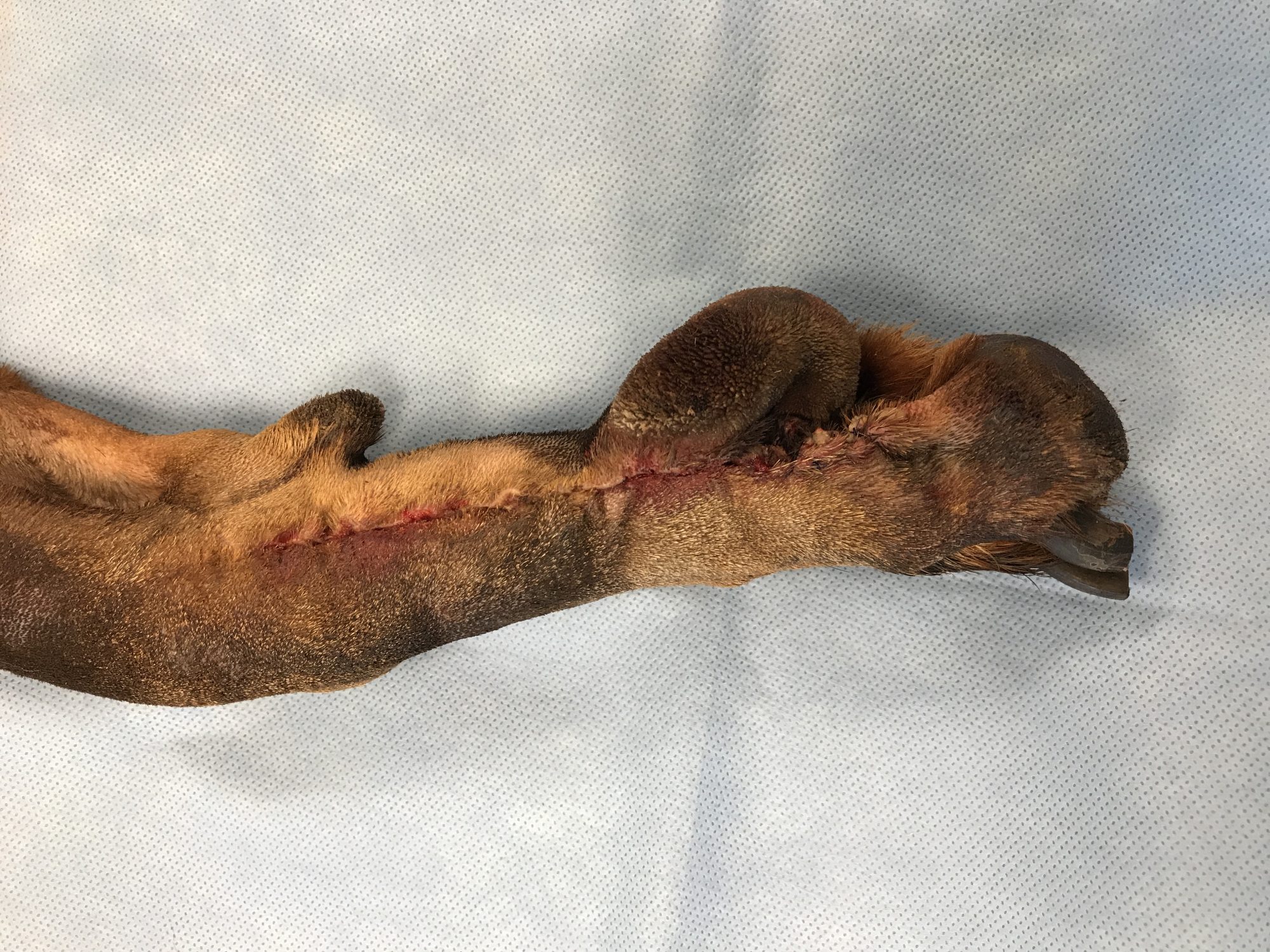
Reagan recovered smoothly from anesthesia. She was given pain medications and antibiotics. She went home with an Elizabethan collar to ensure that she did not cause trauma to the surgery site or cause an infection.
About a week postop, the biopsy results came back. Was bone cancer confirmed?
Amazingly, the report explained that it was all benign. The bone reaction was “reactive and inflammatory”. The changes may have been due to an old fracture of the bone – even though Reagan’s owner never noticed any limping…
Although we don’t have a definite explanation for the swelling and the changes in the bone, the good news is that Reagan made a full recovery and went back to her normal, happy life with a great outcome.
Phil Zeltzman, DVM, DACVS, CVJ, Fear Free Certified

Dr. Phil Zeltzman is a traveling veterinary surgeon in Pennsylvania & New Jersey. An award-winning author, he loves to share his adventures in practice along with information about vet medicine and surgery that can really help your pets. Dr. Zeltzman specializes in orthopedic, neurologic, cancer, and soft tissue surgeries for dogs, cats, and small exotics. By working with local family vets, he offers the best surgical care, safest anesthesia, and utmost pain management to all his patients. Sign up to get an email when he updates his blog, and follow him on Facebook, too!
Who does surgery in a 15 year old dog?
Tucker, a 15 year old Shih Tzu, had a concerning mass on his behind. Every time he sat somewhere, he would leave a bloody spot. He was otherwise healthy. He enjoyed going for a 1 mile-long walk every day.

His owners noticed a small lump forming on the side of his anus. He also developed a larger mass behind the other one. The smaller mass became ulcerated (meaning it broke open) and started to bleed.
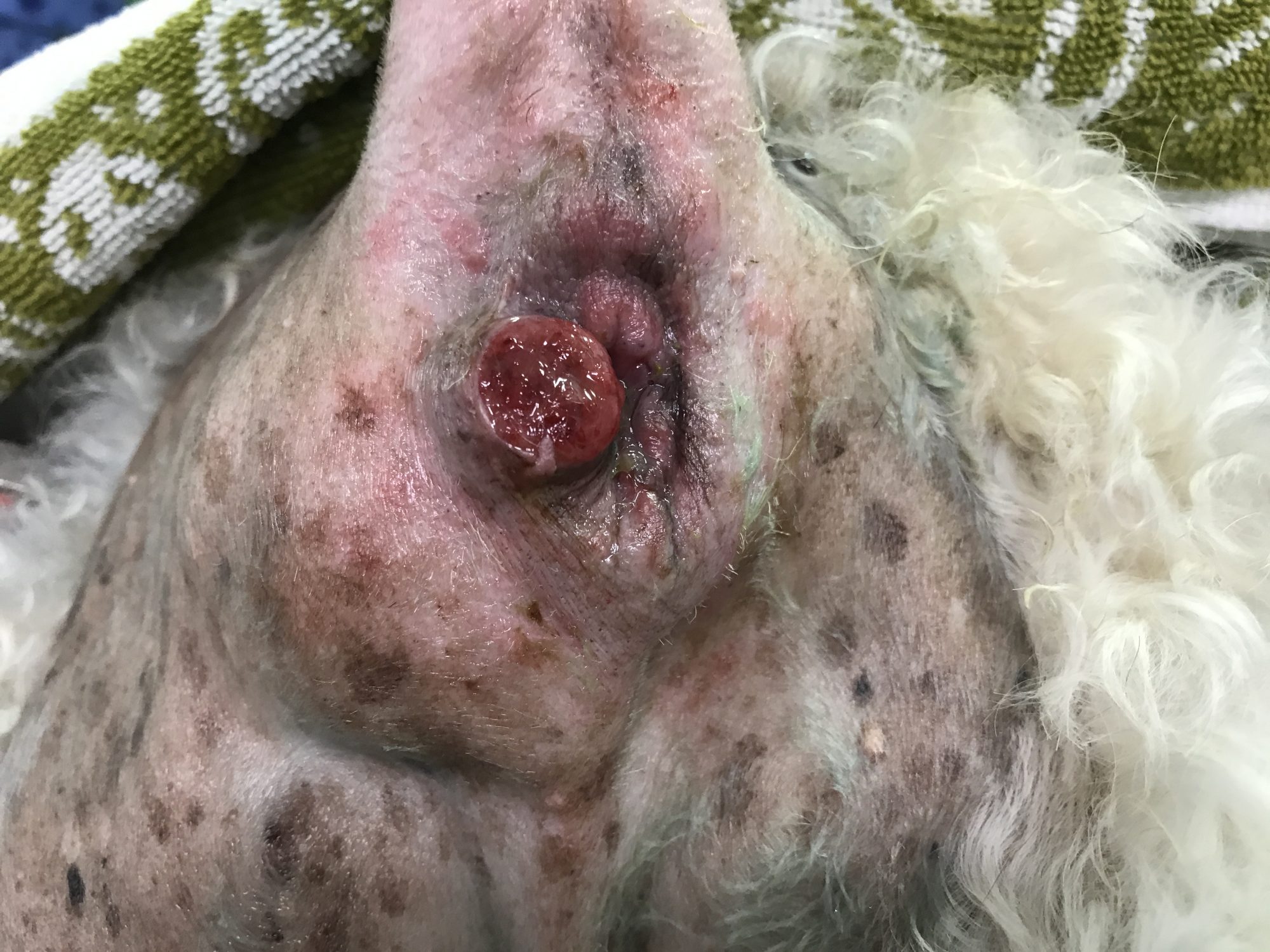
Tucker’s family vet took a cell sample (aka a “Fine Needle Aspirate”) and wisely sent it to the lab. The results showed that the mass was benign, meaning there was no obvious sign of cancer!
Encouraged by the good news, Tucker’s loving owner decided what few pet owners would do on a 15 year old dog: she decided to have the masses removed!
So Tucker’s family vet asked me to remove the masses. Since Tucker had a heart murmur (treated with medications), there was a concern for placing him under anesthesia. He had preop blood work and a comprehensive physical exam prior to anesthesia. Both were good.
Surgery was done to remove both masses. The smaller ulcerated mass was first removed, then the larger one.
Grandpa Tucker recovered smoothly from anesthesia and went home to heal.
He needed to wear a plastic cone and stay very quiet during his 3 week recovery.
A week later, the results of the biopsy came back: the small mass was a perianal adenoma (aka circum-anal adenoma, aka hepatoid tumor), which arises from the sebaceous glands around the anus. No cancer was found and the tumor had been successfully removed completely.
The larger mass was a lipoma, ie a benign fatty tumor.
So both masses were benign – the best news we could have received.
Three weeks after surgery, Tucker went to his family vet to have the incision rechecked. Everything looked good, so he was allowed to resume normal activity and enjoy his walks again.

As I always say, “age is not a disease.”
Tucker can enjoy life without a painful, raw, bleeding mass on his behind.
And Tucker’s dedicated owner was rewarded for her decision to help her 15 year old dog.
Phil Zeltzman, DVM, DACVS, CVJ, Fear Free Certified

Dr. Phil Zeltzman is a traveling veterinary surgeon in Pennsylvania & New Jersey. An award-winning author, he loves to share his adventures in practice along with information about vet medicine and surgery that can really help your pets. Dr. Zeltzman specializes in orthopedic, neurologic, cancer, and soft tissue surgeries for dogs, cats, and small exotics. By working with local family vets, he offers the best surgical care, safest anesthesia, and utmost pain management to all his patients. Sign up to get an email when he updates his blog, and follow him on Facebook, too!
This cutie is a 15 month cancer survivor!
Cartier, a now 14 year old Shih Tzu, had a cancerous tumor in a rib. So we removed 3 of her ribs at the end of 2018.

I am thrilled to report that 15 months after surgery, Cartier the cancer survivor is still doing great!
Read her amazing story here: (https://www.drphilzeltzman.com/blog/cartier-and-the-giant-surprise/)
Phil Zeltzman, DVM, DACVS, CVJ, Fear Free Certified

Dr. Phil Zeltzman is a traveling veterinary surgeon in Pennsylvania & New Jersey. An award-winning author, he loves to share his adventures in practice along with information about vet medicine and surgery that can really help your pets. Dr. Zeltzman specializes in orthopedic, neurologic, cancer, and soft tissue surgeries for dogs, cats, and small exotics. By working with local family vets, he offers the best surgical care, safest anesthesia, and utmost pain management to all his patients. Sign up to get an email when he updates his blog, and follow him on Facebook, too!
You removed this poor dog’s what???
Bodie, a 5 month old Pitbull, was in a pickle…

He had skin missing in his prepuce, which led to exposure of a portion of his penis. Because he was a rescue, there was no known cause. Most likely, this was due to trauma (ie a dog bite), or he was born that way.
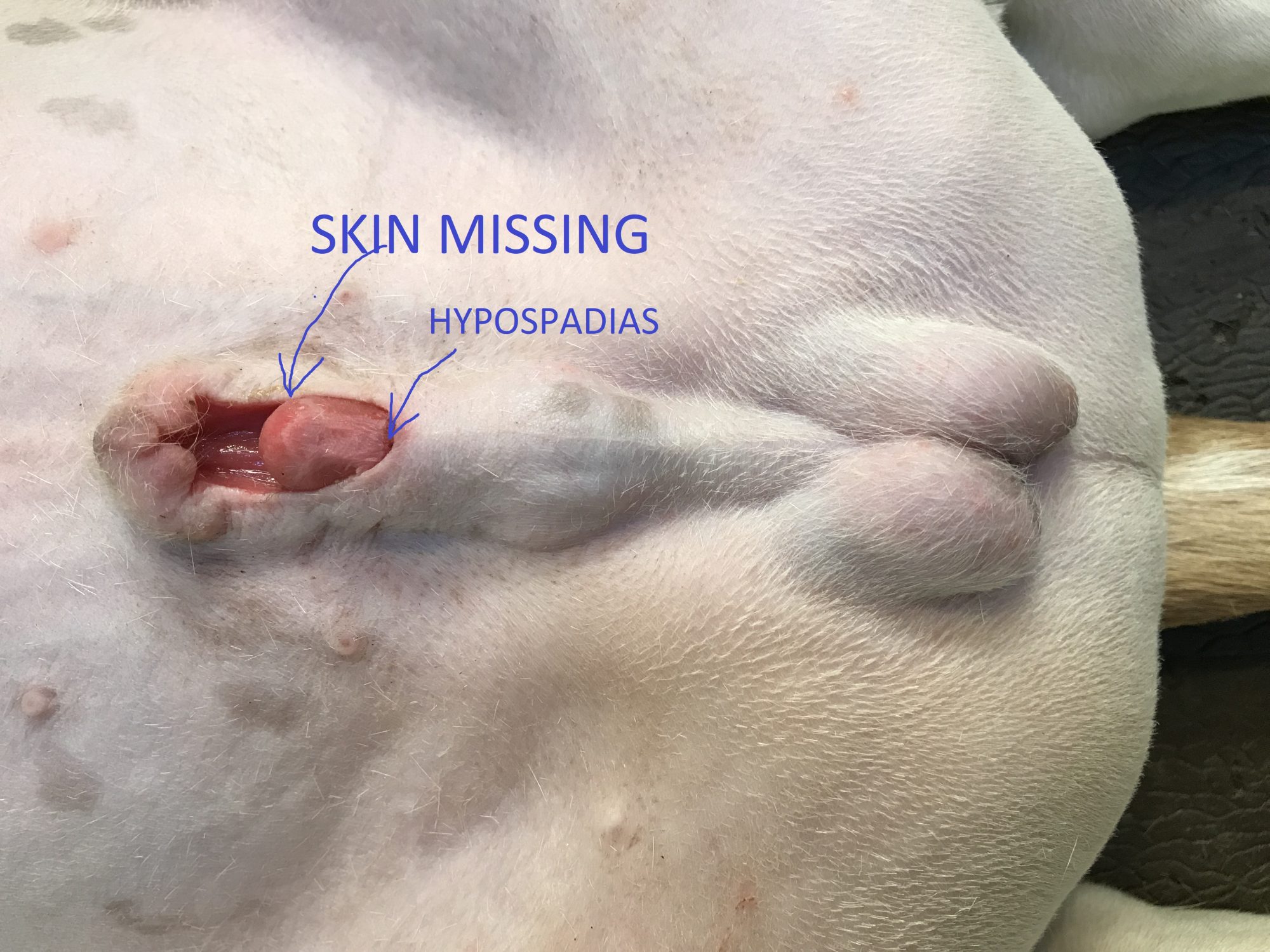
In addition, he had a hypospadias. A what? A hypospadias is a congenital condition in which the opening of the urethra is located under the penis, instead of the tip. This caused problems to urinate.
Bodie was relinquished to a rescue, presumably because his original owner did not want to deal with a dog with this condition.
The only treatment was surgery. There were 2 options: either try to reconstruct a new prepuce, or remove the entire penis (penile amputation). With the second option, a new opening would be created to allow Bodie to urinate (urethrostomy). This new opening is located where the scrotum is.
Given the hypospadias, it was deemed preferable to sacrifice Bodie’s penis.
A full physical exam and blood work confirmed that Bodie was healthy enough to undergo anesthesia.
Surgery went well, and Bodie recovered smoothly from anesthesia.
He went home on pain medications and antibiotics. Instructions included wearing an E-collar (plastic cone) and rest strictly for 3 weeks.
Three weeks later, Bodie returned to the clinic for a progress exam and staple removal. He received a clean bill of health. He was urinating well and seemed completely unaffected by this surgical adventure.
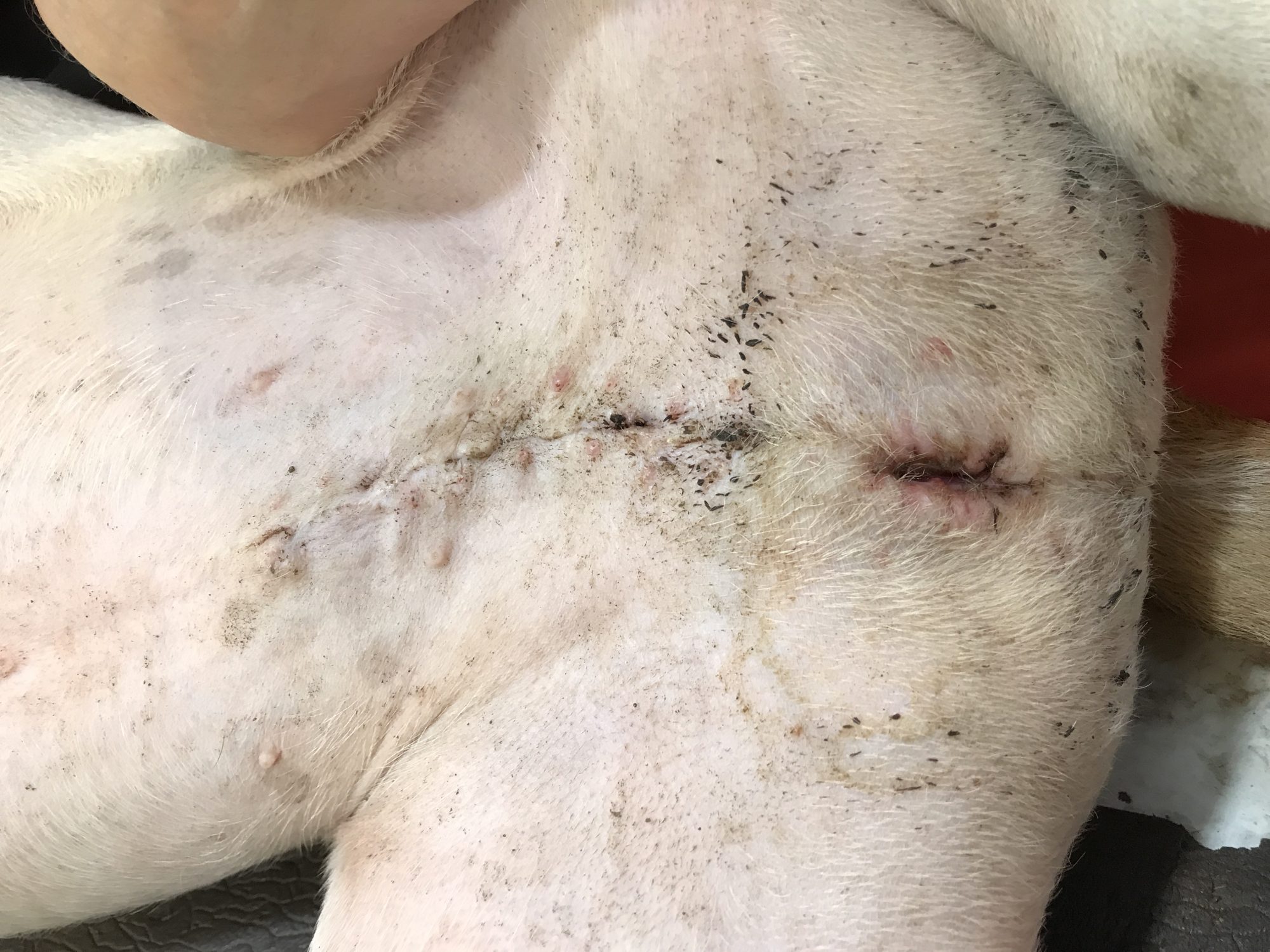
Bodie got a second chance at a comfortable life by ending up in the hands of a generous rescuer who fell in love with him. She was willing to go the extra mile to give him the life he deserves: peeing freely on all the trees in the neighborhood.
He can now look forward to a long and healthy life in his new furever home.
Phil Zeltzman, DVM, DACVS, CVJ, Fear Free Certified

Dr. Phil Zeltzman is a traveling veterinary surgeon in Pennsylvania & New Jersey. An award-winning author, he loves to share his adventures in practice along with information about vet medicine and surgery that can really help your pets. Dr. Zeltzman specializes in orthopedic, neurologic, cancer, and soft tissue surgeries for dogs, cats, and small exotics. By working with local family vets, he offers the best surgical care, safest anesthesia, and utmost pain management to all his patients. Sign up to get an email when he updates his blog, and follow him on Facebook, too!

